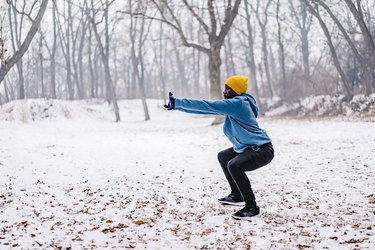

Before you hit the slopes or the rink, properly warming up your muscles and joints is key for preventing injuries and enhancing your performance. That's because winter sports, like skiing, ice skating and even snowboarding, not only require lower-body mobility but also call for balance.
"Most of the time, cold weather will make you stiffer. There's not as much blood flow in your circulation as when you're in a warmer climate," says Zach Ray, DPT, SCS, founder of Live Athletics. "So it's important to heat up your internal core temperature and activate the specific joints and muscles that are necessary for skiing or ice skating."
Video of the Day
Skiing and ice skating mainly use your quads, glutes and hamstrings. And when you hit bumps on a hill or are trying to break a fall while skating, your body needs to be able to absorb impact safely. You do this by activating your core and lower-body muscles, which will keep your knee and hip joints safe, Ray explains.
Follow this 10-minute mobility and balance workout to prep your muscles and joints for your favorite winter sports. Aim to do 1 to 2 sets of 8 to 10 reps per move.
1. 2:1 Depth Jump
Depth jumps help condition your body to absorb force when landing. You start standing on both legs and then hop down to one leg, holding the bottom as you absorb the force, Ray explains. This move teaches your hips to absorb force in a coordinated and balanced way to help prevent falls.
- Stand with both feet hip-width apart, then shift your weight from your heels to your toes. Stand as tall as possible on your toes, raising both arms overhead.
- As you lower your heels and your arms, hop down on one leg, bending your knee and lifting your other foot a few inches off the ground.
- Place the opposite foot back down on the ground and return to standing.
- Do 8 reps on one leg, then repeat on the other side.
2. Bounce Back Lunge
This lunge variation is a great exercise to prepare for skiing as it helps warm up your knee joint and activates your quads. It also helps you with absorbing force when landing, Ray says.
- Stand with your feet hip-width apart. Without moving your left foot, take a big step forward with your right foot, bending your front knee to 90 degrees.
- Press your right foot firmly on the ground to stand back up and return to the starting position.
- Do 8 reps on one leg, then repeat on the other side.
3. Two-Hand Toe Touch
Similar to a single-leg deadlift, the two-hand toe touch engages your hamstrings and glutes, while also firing your core to help with balance, Ray says.
- Start standing and place your weight on your right leg.
- With your right knee slightly bent, hinge your torso forward and extend your left leg behind you until your hands touch your right toes. Your torso should be parallel to the ground.
- Reverse the motion to stand back up, bringing your left knee toward your chest.
- Do 8 reps on one leg, then repeat on the other side.
Tip
If you're not able to touch your toes, aim to touch your thigh, knee or shin.
4. Stork Turn
Stork turns activate your hips and glutes while you're moving your upper back, which mimics the act of ice skating, Ray says. They also help with training stability and balance.
- Stand on your right leg and bend your left leg, pressing it against a wall, exercise box, the side of your car or another stationary object.
- While balancing on your right leg and keeping your gaze on your toes, twist your upper body from side to side.
- Continue for 30 seconds, then repeat on the other side.
5. Heel Toe Shift With Hip Hinge
This glute-activating move allows you to move your hip in full range of motion and helps prevent falls by training your hip coordination and balance.
"When you slip and fall, your hips either go forward or back, so it's teaching you to be coordinated in that full range of motion," Ray says.
- Stand with both feet hip-width apart and hinge your hips back and squat down until your thighs are parallel to the ground, bringing your weight to your heels so your toes are off the ground.
- Come back up to stand tall on your toes and squeeze your glutes at the top.
- Do 8 reps.